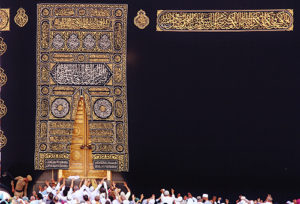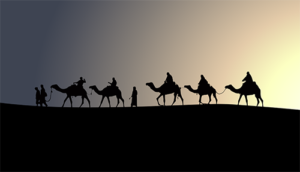There are many differences of opinion regarding the history of Islam and the Islamic world. Our two short pieces are based on things that most people would agree on or that at least have a good grounding in evidence. As Christians, we would not agree with Muslims in many areas relating to the source of Islam, however, for brevity and readability we will write without any qualifying statement, e.g. ‘Muslims believe that…’
Setting the scene
 In the 6th century AD, the interior of the Arabian Peninsula contained a few small towns, among them Mecca and Yathrib (later renamed Medina). These towns were on the trade route from relatively wealthy Yemen to the Byzantine and Sasanian empires in the north. The Ka’aba (cube) in Mecca, where Muslims make their pilgrimage, was a place of pilgrimage even before Islam – though at that time it contained images of many gods and goddesses. There was no single coherent religion and each tribe had its own gods. This time period was known as the Age of Ignorance, probably because they did not yet know of Islam. There was a sense of prophetic anticipation and some movement towards greater integration of the various tribes.
In the 6th century AD, the interior of the Arabian Peninsula contained a few small towns, among them Mecca and Yathrib (later renamed Medina). These towns were on the trade route from relatively wealthy Yemen to the Byzantine and Sasanian empires in the north. The Ka’aba (cube) in Mecca, where Muslims make their pilgrimage, was a place of pilgrimage even before Islam – though at that time it contained images of many gods and goddesses. There was no single coherent religion and each tribe had its own gods. This time period was known as the Age of Ignorance, probably because they did not yet know of Islam. There was a sense of prophetic anticipation and some movement towards greater integration of the various tribes.
It was into this world that Muhammad, the founder of Islam, was born in 570 AD. His father died before his birth and his mother died when he was six. For a short time, his grandfather cared for him, but when he, too, died, his uncle Abu Talib took him in.
Poverty to power
 Though Abu Talib was a member of the powerful Quraish tribe, he was poor, so Muhammad worked as a shepherd when he was a boy. At the age of twenty-five, he was employed by a wealthy widow to join her caravan to Syria. He did well on the trip and on his return, she proposed marriage. She was fifteen years his senior, but he accepted, instantly becoming a man of influence and wealth. The marriage was monogamous and he remained faithful to her for the twenty-five years up to her death.
Though Abu Talib was a member of the powerful Quraish tribe, he was poor, so Muhammad worked as a shepherd when he was a boy. At the age of twenty-five, he was employed by a wealthy widow to join her caravan to Syria. He did well on the trip and on his return, she proposed marriage. She was fifteen years his senior, but he accepted, instantly becoming a man of influence and wealth. The marriage was monogamous and he remained faithful to her for the twenty-five years up to her death.
First revelation
In 610, at the age of forty, Muhammad was meditating in a cave traditionally used for that purpose when the angel Gabriel appeared to him and revealed the first sura (chapter) of the Qur’an. Muhammad was troubled and wondered if this was from Allah or from evil spirits. Then, two or three years later, further revelations came to him.
Initially, he had only a few followers, mostly from his own family. Muhammad denounced the polytheism in the Ka’aba – a brave thing to do as many important families derived important income from the pilgrimage – but he was protected from them by his uncle. However, the threats were real and he sent some of his followers to the Christian empire of Ethiopia for protection.
A vision
In 620 Abu Talib and Khadija both died. Very soon after this, Muhammad remarried twice, eventually taking twelve wives. Pressure on his small band was increasing. He had a night vision where he was carried from Mecca to Jerusalem and from there to heaven where he talked with prophets from the past who confirmed and honoured him. The suras that were revealed to him while he was in Mecca tend to be concerned with aspects of belief and behaviour. The Quraish tribe were opposed to this so Muhammad fled with his followers to Yathrib, where there was already a band of Muslims. Not long after this, the city was renamed Medina.
Success
Muhammad rose to prominence in Medina and became the ruler of the city. However, his money began to run out. It was then that Muhammad received a revelation from Allah to raid the caravans from Mecca. This was generally successful, which confirmed Muhammad’s prophethood in the eyes of his followers. The suras revealed while Muhammad was in Medina tend to be concerned with Islamic law.
In 629 AD, Mecca surrendered to his forces and Muhammad took it. In 632 AD Muhammad died.
It would seem that Muhammad started out as a sincere seeker after the truth. His stalwart persistence in the face of persecution from powerful quarters is impressive. We can only wonder what would have happened if he had heard the real Christian message.
